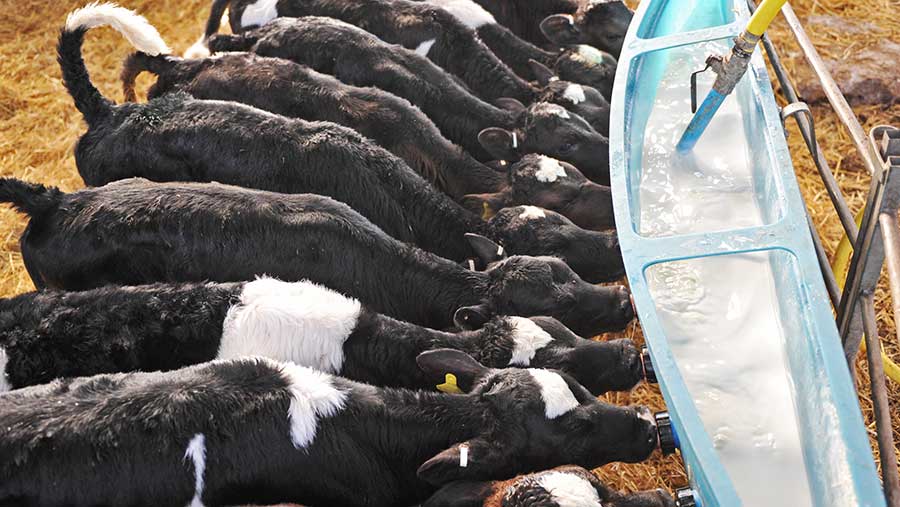What are the benefits of milk replacer for calf rearers?
 © Debbie James
© Debbie James More than half of all dairy and beef farmers in Great Britain now rear their youngstock on calf milk replacer (CMR) instead of whole milk, with potential disease risks a reason for this shift to powder-based systems.
Research carried out by Volac, involving 644 farmers, revealed 58% of dairy calves and 52% of beef calves are reared on CMR compared with a combined average of just 15% 10 years ago.
Farm vet Dave Gilbert, who scrutinised the results for Volac, says a growing awareness of the risk of transmitting Johne’s disease to calves through whole milk is influencing the trend away from whole milk rearing systems.
Volac facts
- £46m – the amount Volac spent on whey in 2017
- 10 – the number of cheese manufacturers supplying the company with whey
- 15% – percentage of cheese manufacturers’ income generate by whey sales
- 153,000 – the number of dairy cows producing the whey used in Volac’s manufacturing processes
- 3m – litres of whey processed daily at the Felinfach factory
See also: Why feeding more milk to calves is more cost-effective
“Ten years ago, I could count on one hand the number of farmers who were testing for Johne’s and managing and controlling it, but now it is the norm.”
Mr Gilbert, of Shropshire-based Dairy Insight, says the threat of antimicrobial resistance from feeding waste milk produced by cows treated with antibiotics is also a factor.
Volac, which manufactures 40,000t of whey-based CMR at its Felinfach plant, carried out a similar survey in 2007.
It found three out 10 farmers didn’t think there were risks associated with feeding whole milk.
What’s driving change?
“Farmers are now much more aware of what they are feeding and the effect that might have on calf health,” says Mr Gilbert.
He believes expansion in herd size is another underlying reason why more farmers now feed CMR.
“Scale is a driver here – the bigger the scale, the bigger the effect of decisions on feeding.
“The dairy farmers I work with today are very different to those I dealt with in 2007; I am not saying there isn’t more scope for change, but the majority of clients are now much more efficient and switched on.”
What to look for when buying CMR
- High levels of milk-derived proteins is preferable, especially for young calves.
- To promote lean tissue growth in dairy heifers, milk replacers should have a high crude protein content, ideally at least 25% on a dry matter basis.
- Don’t use replacers reliant on higher levels of vegetable protein and lower-quality oils that are used to replace milk fat. The utilisation of non-milk proteins in young calves is very poor.
- Milk replacers should also have a maximum of 9% ash declared and a minimum of 0.8% calcium.
- A good-quality replacer powder will dissolve easily and leave no sediment at the bottom of feeders.
- Scrutinise the mixing concentration. A lot of replacers recommend concentrations or feed rates that are lower than the ideal.
- The advice for most situations is to feed 5-6 litres of milk daily at a concentration of 150g/litre (750-900g/day), with higher levels fed when ambient temperatures are below 10C.
Source: Independent nutritionist Hefin Richards of Rumenation
What still needs to change?
The survey showed 20% of milk producers and 28% of beef farmers feed waste milk, potentially contaminated with antibiotics residues. “This practice just can’t continue,” Mr Gilbert insists.
“Feeding healthy transition milk is a very different to the more traditional practice of feeding milk that is unsaleable.”
Changes to Volac ingredient disclosure
The survey showed overall ingredient quality in CMRs is a key feature for farmers.
As a result, Volac global product manager Niall Jaggan says Volac is becoming more transparent with the disclosure of the ingredients that go into making its milk replacers.
Farmers can find it difficult to assess milk replacer quality from the label on bags because manufacturers only disclose the legal minimum requirements, so the constituents usually listed on CMRs are crude protein, crude fat, crude fibre and ash. Commercial sensitivity is the main reason why manufacturers don’t disclose detailed specifications.
But Volac said its recent research showed farmers were keen to make choices based on overall ingredient quality, so in future it will list limiting amino acids such as lysine and leucine to help better inform buying decisions.
“For this market to progress we need to do a better job of informing our customers about the choices they make.”
Farm vet Dave Gilbert welcomed the move. “As a vet, it is tremendously difficult to help farmers when this information is not available when looking at specifications.
“In order to support farmers, we need more information on the nutrition side to help them to make educated choices. Dairy is decades behind pig and poultry nutrition on this.”
Potential risks associated with feeding whole and waste milk
- Johne’s transmission via cow milk. Pasteurisation prevents this, but it is not a panacea because it does not sterilise milk.
- The big benefit of pasteurising is simply decontaminating the milk so the calf is not constantly having to fight a variety of bugs. This often reduces incidence of scours in the group.
- Research has shown bacterial resistance increases in calves fed milk containing residues of penicillin.
- Over time, the effect of underdosing and repeated exposure cause changes in the bacterial flora throughout the calf, especially in the gut. Not only does this cause those bacteria to become resistant, but certain bacteria share their genes with other species they come into contact with. This has implications for viruses such as E coli.
Source: Dave Gilbert
